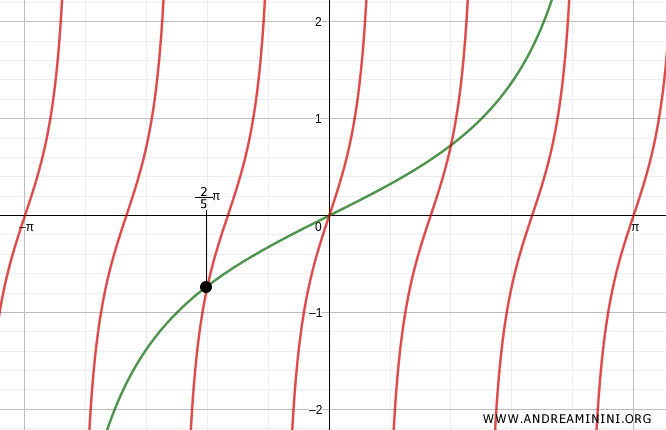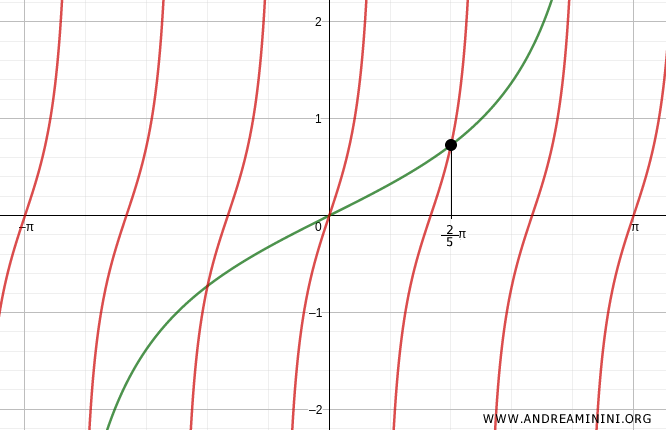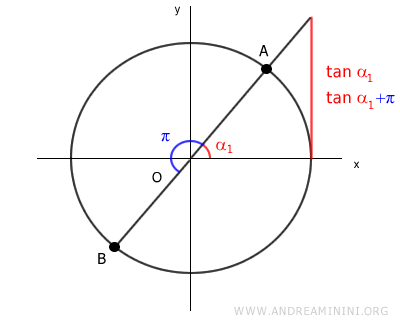Trigonometric Equation: tan(a) = tan(b)
The trigonometric equation $$ \tan \alpha = \tan \alpha' $$ holds when the angles are congruent, meaning α = α' plus an integer multiple \( k \) of a half-turn angle, \( \pi \) radians (180°). The solutions to this equation are given by $$ \alpha = \alpha' + k \pi $$.
The tangent function is periodic, repeating every \( \pi \) radians.
So, this trigonometric equation has infinitely many solutions when considering integer multiples \( k \) of half a full turn, \( \pi \).
Here, \( k \) can be any integer in the range (-∞, ∞).
An Example
Let’s solve the trigonometric equation
$$ \tan \frac{1}{2}x = \tan 3x $$
The angles for the two tangent functions are:
$$ \alpha_1 = \frac{1}{2}x $$
$$ \alpha_2 = 3x $$
Using the trigonometric equation formula for \( \tan x = \tan y \):
$$ \alpha = \alpha' + k \pi $$
Substitute in α and α':
$$ \frac{1}{2}x = 3x + k \pi $$
Simplifying to isolate \( x \):
$$ \frac{1}{2}x - 3x = k \pi $$
$$ \frac{1-6}{2}x = k \pi $$
$$ -\frac{5}{2}x = k \pi $$
Now, multiply both sides by -1:
$$ -\frac{5}{2}x \cdot (-1) = k \pi \cdot (-1) $$
$$ \frac{5}{2}x = -k \pi $$
Then, multiply both sides by \( \frac{2}{5} \):
$$ \frac{5}{2}x \cdot \frac{2}{5} = -k \pi \cdot \frac{2}{5} $$
$$ x = -\frac{2}{5} \cdot k \pi $$
Now, to find solutions to the trigonometric equation, vary the integer constant \( k \).
Checking for k=0
$$ x = - \frac{2}{5} \cdot k \pi $$
$$ x = - \frac{2}{5} \cdot 0 \pi $$
$$ x = 0 $$
One solution to the trigonometric equation is the trivial solution x=0

Checking for k=1
$$ x = - \frac{2}{5} \cdot k \pi $$
$$ x = - \frac{2}{5} \cdot 1 \pi $$
$$ x = - \frac{2}{5} \pi $$
Another solution to the trigonometric equation is x=-\frac{2}{5}\pi

Checking for k=-1
$$ x = - \frac{2}{5} \cdot k \pi $$
$$ x = - \frac{2}{5} \cdot (-1) \pi $$
$$ x = \frac{2}{5} \pi $$
Another solution to the trigonometric equation is x=\frac{2}{5}\pi

By continuing with \( k=2,3,... \), you can find infinitely many solutions to the trigonometric equation.
The Proof
Consider two angles α1 and α2 that yield the same tangent value \( c \):
$$ \tan \alpha_1 = \tan \alpha_2 = c $$
Two angles have the same tangent value under two conditions:
- when the angles are congruent (α1=α2)
- when the angles differ by an integer \( k \) multiple of \( \pi \): (α1=α2+kπ)
Since the tangent function is periodic with period \( \pi \), \( k \) can be any integer.
Graphically:

The second condition also includes the first when \( k=0 \).
$$ \alpha_1 = \alpha_2 \Leftrightarrow \alpha_1 = \alpha_2 + k \pi \quad \text{for} \quad k = 0 $$
Thus, the single necessary condition for the same tangent value is:
$$ \alpha_1 = \alpha_2 + k \pi $$
This confirms the formula for finding the solutions of a trigonometric equation of the form tan α1 = tan α2.
$$ \alpha_1 = \alpha_2 + k \pi $$
And so forth.
